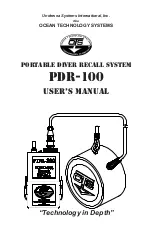
The custom RTL values are stored in EEPROM by transducer
type.
The RTL values for a left transducer and a right transducer must
be the same. The HL limits are directly affected by any changes
in the RTL values.
MODE INITIALIZATION
When the Custom RTL selection mode is selected the instrument
will be initialized as follows:
Tone Type = Current selection
Frequency = Current selection
Channel = Off
+10 dB Pad = Out
Transducer Routing = Current selection
HL Display = Current RTL level stored in EEPROM
Response LED = Off
Stimulus On LED = Off
Low Battery Segment = Current state
" +
Segment = Off
HL SELECTOR
The HL Selector is used to select the custom RTL level. The
level can be adjusted up by 0.5 dB for each clockwise step and
down by 0.5 dB for each counter clockwise step. The transducer
output level (attenuator position) does not follow changes to the
custom RTL value.
The allowable range of the custom RTL value is
dB SPL.
Operation of the knob to select levels outside of this range will
not be allowed. If this occurs, the displayed custom RTL value
will remain the same and will flash temporarily.
FREQUENCY SELECTOR
Selects the frequency for which the custom RTL is to be selected.
ROUTING SWITCH
Inactive in this mode.
EXTENDED RANGE PUSHBUTTON
This pushbutton is used to store the custom RTL value into
EEPROM. After the RTL value is successfully stored the EEPROM
checksum will be updated and the Patient Response LED will be
turned on for 2 seconds. If the SPL value can not be stored
successfully, the word
"CAL" will be flashed on the HL display
and then the previously displayed RTL value will be restored. If
this error occurs, the calibration process may still be continued
for other frequencies.
Summary of Contents for Grason-Stadler GSI 17 1717-9700
Page 1: ...Covers Welch Allyn AM232 Audiometer ...
Page 5: ......
Page 6: ......
Page 7: ......
Page 8: ......
Page 17: ...R 3 P io R 5 Figure 2 1 CONNECTORS CONTROLS INDICATORS 8 ...
Page 23: ......
Page 24: ......
Page 43: ......
Page 44: ......
Page 49: ......
Page 50: ......
Page 53: ......
Page 54: ......
Page 66: ......
Page 67: ......
Page 69: ......
Page 79: ......
Page 80: ......
Page 81: ......
Page 82: ......
Page 83: ......
Page 84: ......
Page 89: ......
Page 90: ......
Page 91: ......
Page 92: ......
Page 93: ......
Page 95: ...Figure 10 2 BATTERY POWER CONNECTION 88 ...
Page 98: ... v7044 0037 17 17 0406 Figure 10 3 NiCad BATTERY OPERATION 9 1 ...
Page 100: ......
Page 102: ......
Page 103: ......
















































